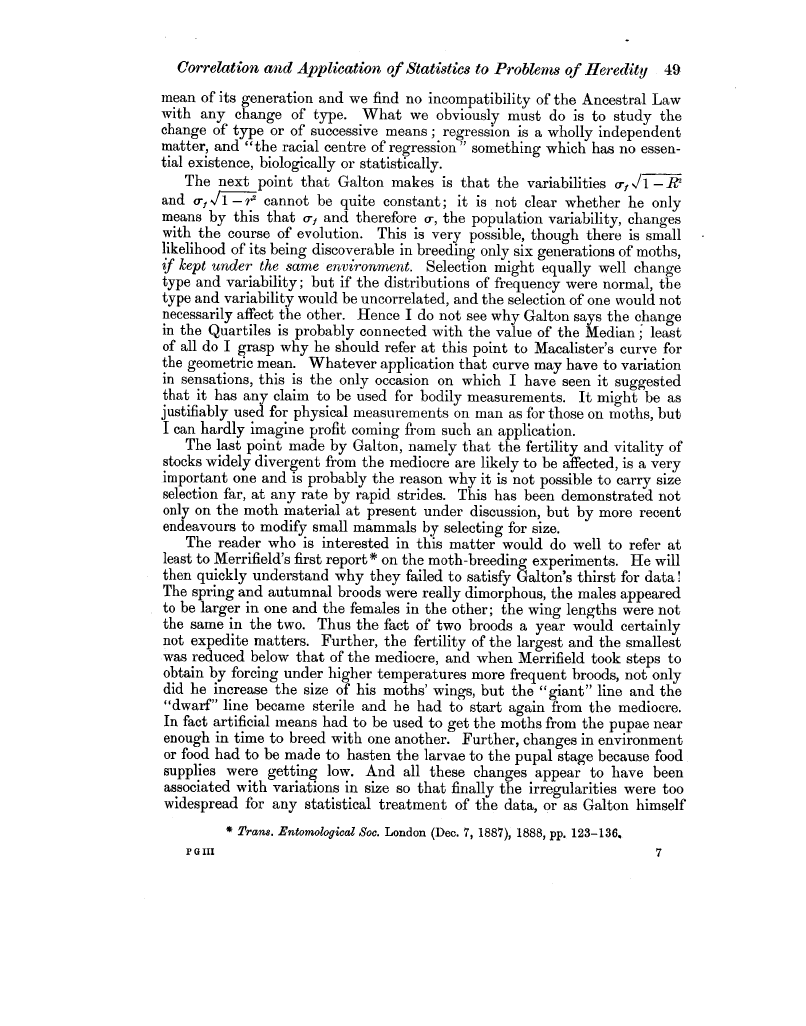| ||||||

OCR Rendition - approximate
Correlation and Application of Statistics to Problems of Heredity 49 mean of its generation and we find no incompatibility of the Ancestral Law with any change of type. What we obviously must do is to study the change of type or of successive means ; regression is a wholly independent matter, and "the racial centre of regression " something which has no essential existence, biologically or statistically. The next point that Galton makes is that the variabilities Qf•/1 -Itand a -f %/I r2 cannot be quite constant ; it is not clear whether he only means by this that o -f and therefore a-, the population variability, changes with the course of evolution. This is very possible, though there is small likelihood of its being discoverable in breeding only six generations of moths, if kept under the same environment. Selection might equally well change type and variability; but if the distributions of frequency were normal, the type and variability would be uncorrelated, and the selection of one would not necessarily affect the other. Hence I do not see why Galton says the change in the Quartiles is probably connected with the value of the Median ; least of all do I grasp why he should refer at this point to Macalister's curve for the geometric mean. Whatever application that curve may have to variation in sensations, this is the only occasion on which I have seen it suggested that it has any claim to be used for bodily measurements. It might be as justifiably used for physical measurements on man as for those on moths, but I can hardly imagine profit coming from such an application. The last point made by Galton, namely that the fertility and vitality of stocks widely divergent from the mediocre are likely to be affected, is a very important one and is probably the reason why it is not possible to carry size selection far, at any rate by rapid strides. This has been demonstrated not only on the moth material at present under discussion, but by more recent endeavours to modify small mammals by selecting for size. The reader who is interested in this matter would do well to refer at least to Merrifield's first report* on the moth-breeding experiments. He will then quickly understand why they failed to satisfy Galton's thirst for data ! The spring and autumnal broods were really dimorphous, the males appeared to be larger in one and the females in the other; the wing lengths were not the same in the two. Thus the fact of two broods a year would certainly not expedite matters. Further, the fertility of the largest and the smallest was reduced below that of the mediocre, and when Merrifield took steps to obtain by forcing under higher temperatures more frequent broods, not only did he increase the size of his moths' wings, but the "giant" line and the "dwarf" line became sterile and he had to start again from the mediocre. In fact artificial means had to be used to get the moths from the pupae near enough in time to breed with one another. Further, changes in environment or food had to be made to hasten the larvae to the pupal stage because food supplies were getting low. And all these changes appear to have been associated with variations in size so that finally the irregularities were too widespread for any statistical treatment of the data, or as Galton himself * Trans. Entomological Soc. London (Dec. 7, 1887), 1888, pp. 123-136. P Ci 111 7
|